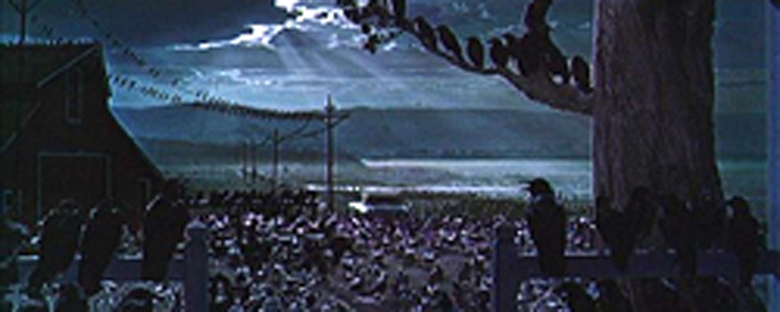Reviews
Alfred Hitchcock
USA, 1963
Credits
Review by Matt Bailey
Posted on 30 October 2005
Source Universal Pictures DVD
Related articles
Features: 31 Days of Horror
Chiranjit / says:
So how do you follow the shock of Psycho? Actually, you try to make Marnie, but when your graceful princess declines the role, you turn your attention to a deranged little tale concerning the more ferocious qualities of nature, involving thousands of voracious birds. Alfred Hitchcock’s The Birds is an absolutely apocalyptic ode to nature’s rapacious response to the threatening presence of a “wealthy, shallow playgirl” that strolls into a calm little community hunting for a new conquest. On the surface, the ravenous raids that follow glamorous Melanie Daniels and her two lovebirds into town could be viewed as a vicious reaction to the introduction of a sophisticated species into an insular ecosystem. However, considering all the tension in that tiny house, the marauding minions might be a manifestation of maternal jealousy, or just an assault on the idea of domestication. Then there’s all that ceaseless squawking and squealing. Whatever the case may be, the recent news of a potential update by Michael Bay, has me thinking the real horror would be watching Paris Hilton replace Tippi Hedren in a vulgar collision of The Simple Life and When Nature Attacks!
Matt / says:
Though I’ve been a fan of Hitchcock—the man’s work covers so many decades in such a vast variety of styles, is there anyone who is not?—I had always been drawn more to his sprightly, early American work like Rebecca, Notorious, and Suspicion than to his more stately late American work like Vertigo and The Birds. Those later films seemed so closed-off, glistening in their vacuum-packed perfection.
It took reading the writings on Hitchcock of Raymond Bellour, a notoriously difficult French intellectual (aren’t they all?) to make me see the beauty in the crystalline structure of Hitchcock’s late American work. It is actually probably incorrect to call Bellour’s work writings on Hitchcock, though. What he wrote in his essays (collected in The Analysis of Film) is more a prescription for the extremely close study of any film, using Hitch’s work of the 1960s as case studies. Bellour’s essay on The Birds is actually a recommendation to the student of film to break down scenes into their components of shots, angles, subject, duration, and movement. By examining the structure of a single scene, regardless of the narrative basis for the scene, new ways of looking at the entire film can result.
It would be foolish of me to attempt a Cliff’s Notes version of Bellour here, but I can say that Bellour’s work—which is most effective when applied to highly-structured, classically-styled filmmaking—allowed me to see the true beauty of Hitchcock’s later films. Though his earlier work was certainly not sloppy, the films from Rear Window to Marnie — a streak of success any director would love to claim as their entire resume — each form a cool, rigorous, architectural structure. The films still seem rather closed-off, but Bellour gave me the keys to enter and explore the rooms.
What sets The Birds apart from the other films in Hitchcock’s incredible ten-year run is its remarkable chilliness. The film features no soundtrack other than the sounds of bird (sometimes electronically manipulated), very little dialogue, and a very small cast. The formal control of this movie is so extreme as to appear diagrammatic. To see one of the scenes mapped out as in Bellour is almost to look at a blueprint. Yet, the film achieves its end. It is still one of Hitchcock’s most popular and most highly regarded films, and just about everybody still gets a little freaked out when passing a large group of idle birds.
We don’t do comments anymore, but you may contact us here or find us on Twitter or Facebook.



